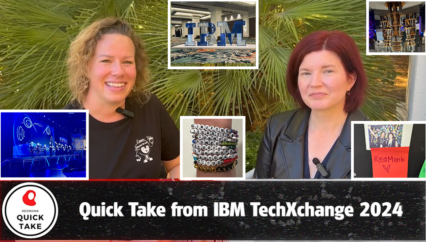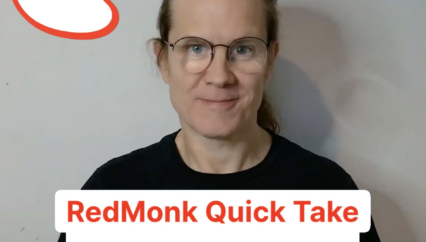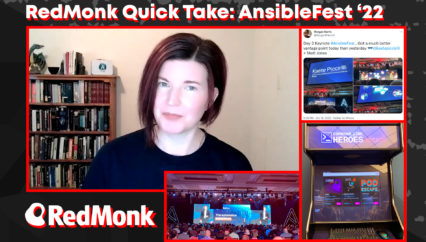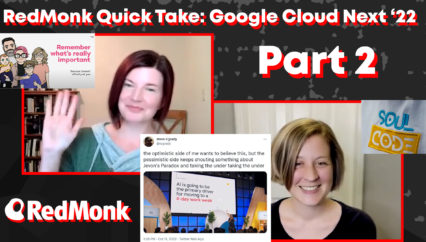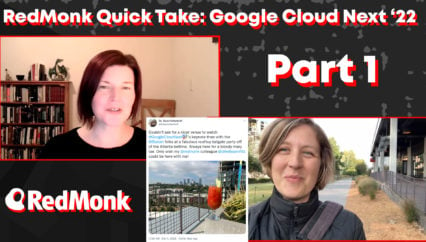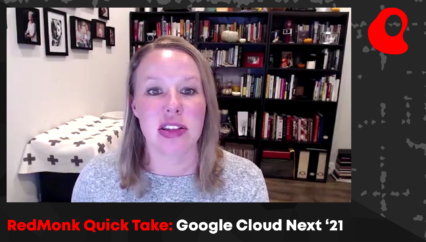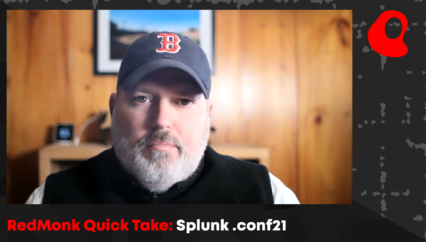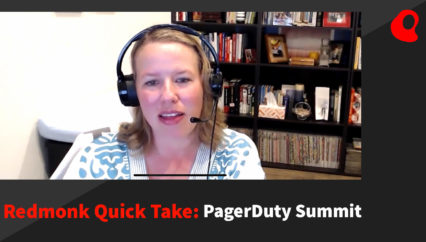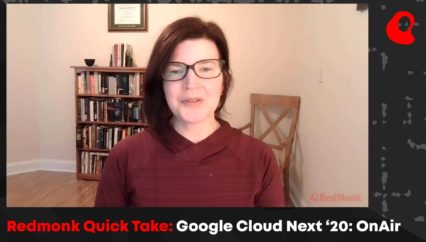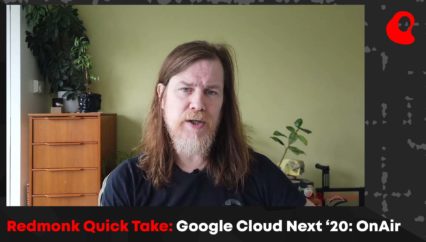In October 2023, Amazon Web Services (AWS) invited RedMonk analysts Kelly Fitzpatrick, Kate Holterhoff, and Rachel Stephens to Austin, TX, so that they could report on AWS technology in action at relevant Formula 1™ events (AWS has an existing partnership with Formula 1™). In this video the analysts discuss their initial impressions, the technology they saw in play, and their overall takeaways from the events.
This was a RedMonk video, sponsored by AWS. AWS also covered analyst T&E to Austin, TX and entry fees to the events.
Related resources:
- Learn more about the tech involved in AWS’s racing partnership: https://aws.amazon.com/sports/f1/
- Learn more about the tech involved in AWS’s team partnership: https://aws.amazon.com/sports/ferrari/
Rather listen to this conversation as a podcast?
Transcript
Kelly Fitzpatrick: Hello, this is Kelly Fitzpatrick with RedMonk here with a quickish take on some of the experiences that my excellent colleagues, Kate Holterhoff and Rachel Stephens and I had at the 2023 Formula 1™ US Grand Prix™ in Austin, Texas. Amazon Web Services or AWS, which has an existing partnership with Formula 1™, invited invited us to this event so that we could report on AWS technology in action. This was an action and data-packed weekend for RedMonk, and in order to capture some of our immediate takeaways, I managed to get Kate and Rachel miced up and on camera after our first day at the event. So my job today is to give you some context around what we saw and then send you over to Kate and Rachel for their excellent insights. So first, a little bit about Formula 1™. It involves really fast, custom-built race cars, and to prepare ourselves for experience beforehand, my colleague, Rachel, filmed a series of really great Get Ready with Me videos to learn more about Formula 1™. So check those out if you get a chance. In addition, we also watch Netflix’s documentary series, F1™ Drive to Survive. And for more on this series itself and impressions from Austin, here are Rachel and Kate.
Rachel Stephens: I watched Drive to Survive just to try to… as a crash course to get ready for this, but I’m 100% going to keep watching it afterwards. I think the show is incredible. I really enjoyed the drama of it. It’s very good.
Kate Holterhoff: Yeah. I mean, the Grand Prix™ here has really taken over. Just the number of folks who came to watch the qualifiers yesterday, it was beyond anything, especially if it’s hot
Rachel: It was a hot day.
Kate: It was so hot.
Rachel: It was 96 degrees in October in Texas. Come on.
Kate: I know.
Kelly: So, what is a Grand Prix™ event like? On Friday, we saw a practice session, which is where drivers test out their car set up on the actual circuit because the tracks and track conditions can vary from location to location. Later on Friday, we saw the qualifiers, which Kate and Rachel mentioned, in which drivers are going for their absolute fastest single lap, and in Austin, each lap is about 5.5 kilometers or 3.4 miles. The fastest lap times on Friday determine the starting position for each car during the main race on Sunday. So fast forward to Saturday, where the main event was a 100 kilometer or 62 mile sprint race, which is a totally different event from the main race on Sunday. And then on Sunday was the main event, the main race, 308.4 kilometers or 191.6 miles. While we saw the US Grand Prix™ in Austin, the number and location of Grand Prix™ races in a Formula 1™ Championship season can vary. In 2023, this schedule started in very late February with a test session, and the last Paddock Club™ wraps in late November for a total of 23 rounds in addition to the test round. Often, Formula 1™ events will happen on back-to-back weekends, meaning that the entire F1™ production, including all 10 teams with two cars per team and the F1™ staff itself, has to pick up and move to an entirely different country sometimes in a matter of days.
We were in Austin when the weekend. The next week in the entire operation was off to Mexico City, and São Paulo, Brazil was on the docket for the weekend immediately after that. RedMonk was at the Grand Prix™ courtesy of Amazon Web Services or AWS, who were excellent hosts throughout the weekend. They set set us up with tickets to something called the Paddock Club™, which is the type of place where when you walk in the door, they immediately hand you a glass or a bottle of sparkling wine. AWS also set us up with some pre-briefings on this sport itself, the relationship among car driver and race engineers who are trying to optimize everything. We also got to see some of the data that race engineers leverage to optimize elements involved in the overall performance of the car. In addition to their own experts, AWS set us up with personnel from both Formula 1™ and the Ferrari team, both of whom have partnerships with AWS. One event that really stood out for me was our visit to the Formula 1™ Broadcast Centre or Event Technical Centre, which is on site and is responsible for sending feed and data for broadcast and also sending data to the teams.
It is currently staffed by about 300 people with 170 people on site, and keep in mind that site moves around sometimes week to week, and 130 at their home base location in UK. We got to speak with Pete Samara, who is the Director of Innovation and Digital Technology at Formula 1™. It’s a really important job. And one of my very specific takeaways from the event was how important latency is to the technical center. It’s really interesting how the technical center handles latency, especially given that every broadcast is from a different location around the world. And what they figured out was that rather than achieve the absolute minimum latency that they could at any given moment, what they aim for is a minimum consistent latency because if they have that consistent latency, they can plan around it and everyone does better, whereas a more variable latency can be tricky. I believe that Pete said that from Australia, the race location that is farthest away from the home base in the UK, they could consistently achieve a latency of about 300 milliseconds. Now that you have some sense of what Formula 1™ is all about and some of the variable opportunities that RedMonk had at the Grand Prix™ event in Austin, courtesy of AWS, let’s check in on Kate and Rachel for more of their takeaways from the event.
Kate: So Rachel, some of the things that we’ve been hearing about F1™ and its relationship to AI is that there are these parallels that customers are seeing. What are some of the ways that you’ve heard AWS folks and that entire community talk about how AI is going to innovate?
Rachel: I was really surprised by some of the answers. We were able to talk with Pete Samara. Was that the right name? Yes. Pete Samara. He’s delightful, and he helps run the on-site data side at the F1™ track, and then they coordinate all of their data back to a central location in London, and then they broadcast it all out to the world. It was an amazing operation. Somebody asked him about Gen AI, and I was searching in my head the latency of the ‘type a question into ChatGPT and watch it type out a response’. It’s like with an operation like theirs where the latency is milliseconds, there’s no way that Gen AI can fit into that. He had some really amazing ways that he was talking about it in terms of, maybe not in some of that real-time way right now, but in terms of helping them figure out camera shots or the most interesting things that are happening in the race that they could highlight for people and using it in different ways to try to just make their overall analysis better. So maybe it’s less about like, let me type my query into ChatGPT in natural language, which their querying and indexing is absolutely astounding.
But it’s a little bit less like that. It’s more about how can we create a better, holistic and more strategic product, which I thought was phenomenal. What about you? Anything stand out to you?
Kate: Well, we talked to a lot of interesting people yesterday, and I think I’m, like Rachel, still processing all of that. But yeah, when we talked to Pete, he spoke a lot about the data management issues, and I think that that’s where we’re going to see a lot of innovation, especially with ways that AI can help with that. The fact that F1™ has been around for a while, so they’ve got some legacy systems that they need help modernizing. It seems like that’s going to be a real opportunity for them to step in and try to help with that process. Like you, I was really astounded by just what a significant operation it is for them to move from city to city as part of the Grand Prix™ circuit. Then just taking into account the audience needs, not only with the education, but also with ensuring that they’re giving audiences what they want out of that experience by following the stories of the drivers, but also making sure that they’re highlighting the capabilities of the cars themselves.
Rachel: When Kate was talking about moving everything city to city, they are bringing this thing, they build their own building. They have a building that they build. They bring their own fiber, they bring their own generators. It’s like they have no outside dependencies. They are moving all of this stuff all around in the world every time and resetting up their entire data center. Basically, it was phenomenal.
Kate: So one of the things that Pete talked about was the hybrid cloud strategy and what that is looking like and how that’s going to evolve going forward. Can you talk about that at all?
Rachel: I can sure try. I don’t know if I’m getting all the details right. So they moved from something that was really — everything was mobile, and they moved to a cloud-based operations environment. So one of your questions was like, do you just have all of these years of archived videotapes sitting somewhere? It’s like, no, all of their years of history are all in the cloud. But then they also are pulling things directly down on-prem for latency purposes. So they have things that are existing on-prem in their London-based location. They also have everything stored in the cloud and they have a really complex way of moving things. And in terms of their hot and cold architectures, it’s like things that are historical data in F1™ for some of the things could be things that happened two minutes ago. And then you also need some of the things that are happening. What is historic? How does this all work? So they have a really interesting interplay between what data they need current, what data they need to go into a more cold storage. And so they’re using things like Glacier, and they’re also using all of these really hot architectures. They’ve built their own custom.
When I asked them about their data, they have custom ways that they’ve done all of these things to make it so that they can access everything with the latency they need. I truly cannot comprehend the logistics of this setup. It’s a really big team of really smart people doing a really hard thing.
Kelly: So as analysts, we often get to geek out about data. However, in Austin, we had the opportunity to visit the pit wall and the Ferrari garage, which let us see how and where F1™ teams access data and translate it into action. For those who don’t know what the pit wall is, it is this long island situated the space between the pit lane and the actual racing lane. The pit wall set up for each team is across the pit lane from the team garage, and team members of the pit wall have access to data via dashboards, comms via headsets, and then lines of sight to the race lane, pit lane, and even the pit crew. We were in a demo pit wall at the end of the pit lane so that we did not interfere with any of the teams. Here’s what Rachel and Kate had to say about the experience, followed by their takeaways from our visit to the Ferrari garage.
Rachel: When we got to go down during the qualifying race and sit right along the pits and put on those really big cool headphones, and you could see the cars in front of us just streaming past really quickly in between the crack and the monitors. But we had access to all of the data that all the teams did. You could see as their speeds increased and decreased, and you could see how their tires were wearing. We could see how you could pick drivers and see how they’re doing head-to-head in terms of their lap times. Then behind us, all of the people were coming in and out of the pit. There was all of these cars just within feet. Like I was within feet of all of these amazing race cars. It was just phenomenal. So fun. But I loved seeing all the data and how they figure out the signal from noise and all this. Even they gave us the signal. Was it a million data points per second or something that’s coming off of this track? It’s like, even what they gave us, like they gave us these are the crucial things that you should know from these millions.
They’ve already filtered it down to these are the relevant pieces of information. And even to me, I was like, this is still so much. The ability to know what it is such a technically complex sport. It was astounding to me.
Kate: Yeah, I would say sitting on the pit walls, one of the most exciting parts of this. They walked us across, we had to sign a waiver, and then we put on these headphones, and it was so cool.
Rachel: They walked us across the pit while the race was happening. That’s an extreme level of trust in my ability to move quickly enough. I found that a little stressful.
Kate: Yeah, it was definitely a highlight. But yeah, I mean, standing in front of those dashboards and seeing all the different rubrics that they can follow. I mean, it was really incredible. It gave me a deep appreciation for the role that data plays in the sport. Oh, my God, the garages were so interesting. Well, for one, I love that they each are so highly on brand. I mean, you walk down the avenue where all the different hospitality suites are and all the different cars, and everybody is wearing their colors. There were some folks with branded hats, and so that was a lot of fun. But then when we actually walked into the Ferrari garage, we, of course, had photo ops in front of the Ferrari logo. Rachel was wearing her Ferrari shoes, so she was looking…
Rachel: I was very excited. I think I struggled because they go… The whole day is a lot of put your hands in your pockets, touch nothing when you get to go do all these cool things, which was great. But the only place I really struggled with this instruction is in the garage, just because they have all of these walls of tires and they all look so smooth and I just wanted to pet them all. I just wanted to tell you it looks so smooth and soft.
Kate: And that was before we really understood the role that the soft and medium tires had, how important that is to the race strategy.
Rachel: Yes. I also learned that each driver has a set number of tires for the weekend of each type. And so part of your strategy is figuring out which tires you want to use in which race and which weather and which track conditions. It’s huge. Like your pit strategy and your tire strategy is a huge part of your race. But one of the things we saw on the screen is as the track heats up and your tires get grippier, the speeds go faster. And we could see that on the dashboard. You could see the lap times increase as the tires got hotter, basically.
Kate: I think one of the things that was really impressive to me was that they had the car completely stripped down when we viewed it. I mean, the tires weren’t attached. They had it on a hydraulic lift and there were about, I don’t know, like five-
Rachel: The front was off!
Kate: Exactly, yeah. There were like five guys leaning over it and they were lifting up the back and putting it… Anyways, I mean, it was just remarkable to me. I mean, it looked a little bit like Lego blocks the way that they would disassemble and then reassemble this car.
Rachel: I think it’s such a complex machine in their ability to reform it. And they were saying that when they ship the cars from Grand Prix™ location around the world, basically they have a little tub that the driver sits in. Everything else comes off the car and they ship it all stripped apart, and then they rebuild the car every single place they go. And they have tons of spare parts and all the kit, but their ability to… And they were saying, for the most part, they can rebuild the car in a matter of hours unless there’s some major damage. But I don’t know. The whole thing has made me wish that I studied more science and mechanical things because that’s just phenomenal. This is a skill set that is very impressive.
Kelly: So far, we’ve heard a lot about Formula 1™, the fans, the travel schedule, the tech, the cars, and the technicians who make everything happen. But at this point, you’re probably asking, what about the drivers? Well, to better understand the relationship among the drivers, cars, and the teams that support them, we talked to Rob Smedley, who is currently an AWS brand ambassador, and among other things, a former Ferrari race engineer. He was kind enough to brief us with a presentation on Friday morning before we left the circuit for the qualifiers, and Rachel and Kate also had a chance to chat with him further at the Paddock Club™. Here are their takeaways, and I’m also going to let them have the last word on our time at Formula 1™ in Austin.
Rachel: I don’t know if any of my questions stood out to me as much as your question around the role of human and machine interactions. And one of the things that he said in the presentation is there’s so much work to optimize the machine in terms of other people’s strategy and the heat and the temperature and all of the different things that are going into how you plan to race that day. It’s just minute little tweaks that you can do that can make really big differences in all of your outcomes. But the one thing that you can’t necessarily plan around is the driver. You can do a lot. But I think, one, I think realizing how athletic of a job it is to actually control that race car and the reaction time. So they did a lot of slowmos of showing us that, slowing down the driver and showing us all of the different things that they had to do to correct a car when something went wrong. It was really incredible. And these drivers are so skilled. But then he also gave in terms of what happens if your driver had a fight with their partner before getting in the car.
And all of a sudden, they’re not in the right head space and things. So there’s a lot of things that you can’t necessarily plan on. So your question was around, is there ever going to be a move to remove that variable. Would you ever do driverless cars?
Kate: Yeah. And he was like, absolutely not. I mean, that’s what the fans are interested in, in having that personality. But then F1™ is branded around man and machine, which is something that is unacceptable to try to remove that. But I do think it’s interesting that if AWS is so focused on data, how is it that you can manage all of these these aspects. The changes that they’ve spoken about have been like milliseconds. So the reaction time is a big part of it, but then also trying to convince drivers to actually follow some of the instructions that their pickers are sending them could be a challenge.
Rachel: I enjoyed that exchange because somebody said, the guidance that you can… We don’t call it guidance, we call it instructions.
Kate: It’s so funny.
Rachel: But it’s also things like trying to… There’s team strategy versus personal driver strategy, which is part of it. If you have two drivers going ahead and you want the second driver to go because that would be better for the overall team. There’s some really human and competitive elements in that. That whole thing is so interesting. But I love the way that Rob phrased it. It was like humans are here to watch humans, and it’s the human element that makes it fun. It’s that competitive spirit that makes it fun. It’s that element of surprise that makes it fun. We can optimize things as much as we can on the machine side, but we still have to have that human side to make it an enjoyable experience for the fans and for everybody.
Kate: Yeah. One of the things that really helped me to understand the race better. We’ve heard a lot of talks on this, and I think a lot of the presenters have shown us a chart of the track. It’s this black line around the track. Then they’ll show us where… use a heat map to show these hair pin turns. It’s like, okay. It didn’t really have a visceral effect on me until yesterday when I was able to actually get into this, basically a hay ride for adults, which was semi-trailer with a big cart on the back. They drove folks who were at the Paddock Club™ around the track. We actually got to see this poor truck driver try to take some of these turns with this huge trailer. Around and trying to imagine what the F1™ driver is…
Rachel: They doing it at 160 miles an hour.
Kate: Exactly. They have to slow down to all of 89. I don’t drive 89 on the highway. Oh, my God. It was really…
Rachel: Sometimes I do.
Kate: We got a daredevil over here! But that to me really helped.
I couldn’t visualize. I couldn’t just feel how large the track was. I also couldn’t understand that these are not just a normal turn on the road. These are actually exaggerated. They are hair pin turns. Just the amount of control these drivers have, they were truly athletes. That was meaningful.
Rachel: When we were talking about the Rob Smedley part, I loved the part where he talked about the heat maps, but they talked about all of the different major forces. So it’s like drag and downforce. And what are the other ones? Grip and power. But they use the heat maps as like, this is the part of the track where this element is most important. And then how some of these are offsetting things like your drag and your downforce might not be the things where you’re making trade offs and how you think about those trade offs based off of the track you’re on. I don’t know. I’m walking away from this just continually being impressed by the drivers and just impressed by the analytics that go into this. It’s just amazing.
Kate: Oh, yeah. I think having the actual experience really helped to make it concrete for me because it all felt very abstract. I can look at an architecture, I can look at a schema of how things are supposed to happen. I can look at a wall of data like we did yesterday. They had the monitor up there with all the data. But unless you’re actually watching those cars go faster than anything I’ve ever seen in my life on the ground, basically through the fence, we were watching it. Here’s the monitor. They’re just zipping by. That really made it feel more real to me. It brought that data into the real world and made it much more, I don’t know, something that I could hold on to.
Rachel: It was unbelievable. I didn’t realize that this was my bucket list, but it turns out I did something that was on my bucket list yesterday. It was amazing.
Kate: You’re rewriting your bucket list.
Rachel: Do you do that where you make yourself a list and then immediately cross something off? That’s what happened to me yesterday.
Kate: My philosophy is to just say yes to everything. It’s like, Hey, I’ve never done this before. I’m all in. I’m all in.
Rachel: So yes. It was amazing. Thank you, Amazon, for making this happen. This was a money can’t buy experience. This was once in a lifetime.
